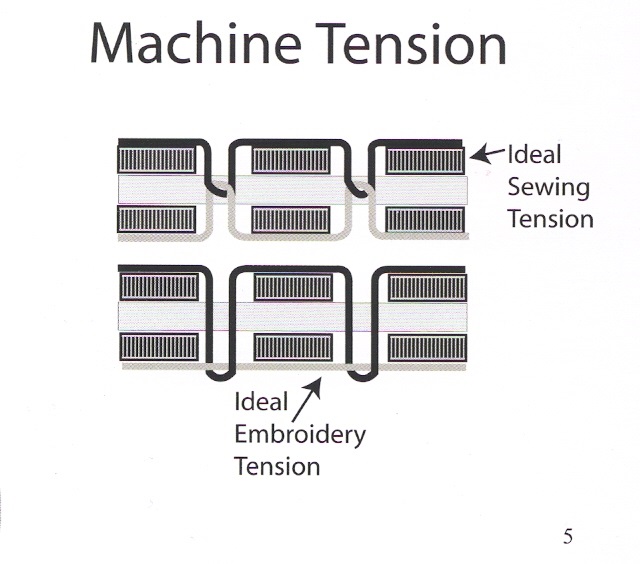I was thinking the other day about what one thing will make a difference for a Newbie learning embroidery. Even for an experienced embroiderer, what sort of information might be of help to everyone. Well, it came to me that there is one underlying piece of info that always must be understood and accurate.
- This item is the basis for all embroidery.
- It is the place where too many things can go wrong.
- Even if your thread and bobbin are accurate for your machine, you must be sure of this.
- Regardless of the stitch, everyone has this information in common.
- Digitizers and the software that can produce digitizing also make sure this is in place.
- It is the single most difference between sewing and embroidery (via machines).
- It is the knowledge that can help a newbie understand what embroidery should look like.
What should a simple embroidery stitch really look like?
How does the machine create a stitch?
This is a simple sewing stitch followed by a simple embroidery stitch:

Review your results for accuracy. Use multiple brands of thread. NOT all 40 weight is the same.
The circled items are not in keeping with a good embroidery stitch.
Make notes of any unusual issues you may observe. BTW, I highly recommend using a file folder, notebook or computer document to keep all your notes on your embroidery. You will be GLAD you did!
Here are the tension tests for the various formats. Download and use the test often. It depends on the number of times you embroider as to how frequently you should run your test. Just like tires on a car can be out of alignment, so can your machine. Most of the time, you can adjust the tension yourself, but sometimes a technician needs to be involved. Your machine is precision equipment. Care for it, have it serviced and it will be a joy for a long time.
TensionTestDST.zip (372B)
TensionTestEXP.zip (248B)
TensionTestHUS.zip (351B)
TensionTestJEF.zip (300B)
TensionTestPCS.zip (4.1KB)
TensionTestPES.zip (1.1KB)
TensionTestXXX.zip (295B)
Here is my Freebie, I hope you will be able to use it often.
Tip:
When I found this one, I was just astounded, No ELBOW GREASE. Do not do any work on this, do not scrub. I think I would have used kitchen gloves but after that, this is one of those no 'brainers.'
Here is my cookie sheet as it was in my kitchen - untouched and unedited:
The next photo shows the mixture on the pan. It is about a cup of baking soda and a cup of peroxide. They are mixed together. As I mixed them, on the pan, the mix started to clean before it was entirely mixed, it turned a beige color. The white dot in the center is a small chunk of baking soda.
The pan was left to sit for about 4 hours. I think overnight would have been a better idea. As I cleaned off the nearly dried mix, the clean underneath was amazing. Give it a try, don't scrub, that would be too much like work.
The original 4 circles are from hamburger patties that I cooked in the oven for some unknown reason. Who bakes hamburgers??? Well, it is an example of an experiment that was less than interesting. After all, I have to test all sorts of things, don't I?
Finally, I want to express my sadness at the passing of Robin Williams. He was not just a comedian, he was also a philanthropist, most notably to (IMHO) the St. Jude Research Hospital where he participated in commercials, the USO, Comic Relief and the Red Cross.
Then, he contrasted his work with extraordinary acting. My personal favorite was One Hour Photo as a stalker. What wonderful acting in an intense movie.
Robin's legacy may include humor and acting, but his greatest gift was a sacrifice beyond compare. Someone you know is in pain, there can be few if any warning signs. Reach out, you have no idea when your love will change someone, even the world.
RIP Robin